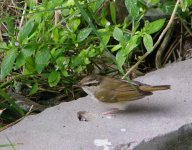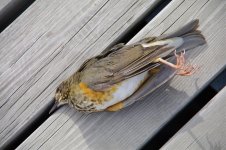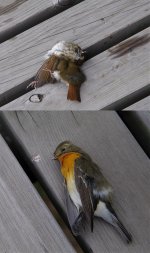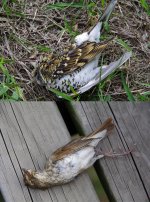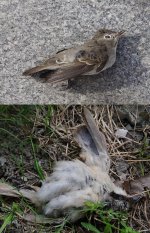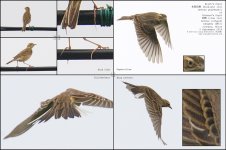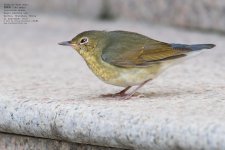Hey Craig! Sorry for the delay, but the report was very helpful!
Awesome, Cypselurus92! Keep checking the
Index to Craig's Reports whenever you're about to take a trip in the area.
... Cuckoos were also very common, but could not be identified down to species level. Other common passerine migrants common during the visit were Richard's Pipits, ... There were a few Pale-legged/Sakhalin Leaf Warblers as well, but these were harder to tell, due to the confusing duo being in autumn and lacking their more distinguishing characteristic- song.
And I suppose the phyllo on the picture is a pale-legged? Or can a plumbeitarsus have such pinkish legs?
Hey Cypselurus92, good work on the cuckoos! I just don't see a way to ID juvenile Cuculus cuckoos to sp. level. 5 Cuculus cuckoos live in China; 3 of them (Common, Oriental, Himalayan) are virtually indistinguishable in adult and juvenile plumage. Juvenile Indian and Lesser
may be distinguishable, and Michael Grunwell, whom Elaine and I had the pleasure of birding with up in Yangkou last week, swore we were seeing juvenile Lesser Cuckoos; but I wouldn't go that far.
As for Richard's Pipits, you're probably right; you probably were finding Richard's. However, it's worth knowing that in this part of China, a species very much like Richard's, Blyth's Pipit, is regularly recorded, though much rarer than Richard's. With that in mind, it's worth making a quick check of the blackish centers of the median coverts. If they're strongly triangular, then it's highly likely that you're looking at a Richard's Pipit. If they're squarish, then you may be looking at a Blyth's. There are also differences in voice, especially song (but you'll be unlikely to hear the song of Blyth's in this region), but also call; but the differences in call are subtle, and one would need to hear them well to be able to make an ID, and even then preferably in combination with a good look at the blackish centers of the median coverts.
The median coverts are not a foolproof characteristic, by the way. Note the photo here of a bird which most of the experts I polled said was probably a Richard's but that had squarish blackish centers to the median coverts.
DKihlberg and Cypselurus92, let me address your observations of birds that may be Pale-legged or Sakhalin Leaf Warbler. First off, David, the bird you photographed is very likely a Pale-legged/Sakhalin Leaf Warbler; those tarsi and toes are very pink. I'd like to see the lower mandible, however; Pale-legged/Sakhalin has a black spot on it that has been a consistently reliable characteristic in my observations. As to whether the bird you photographed (and the birds Cypselurus92 saw) is a Pale-legged or Sakhalin Leaf, the word these days is that there are only two ways to know: by hearing the song (not the call; the call is similar in both sp.) OR by catching Pale-legged/Sakhalins and measuring bill length, etc. See
this link on Facebook for an example.
I failed on the parrot reedbills both in Nanhui and Yangkou...
I'm getting worried. Reedbeds are being destroyed around Nanhui, and you struck out in Yangkou, where destruction and fragmentation of the reedbeds continue apace. I think the "reliable Reed Parrotbill place" in Yangkou, where we dropped you off on your last day, needs to be combed through. Last month, I did hear Reed Parrotbills on the dirt road N of the temple, but with the destruction of habitat in Yangkou, I have to think that Reed Parrotbill is going to be affected.
... The huge hotel at Nanhui really seems to be an efficient killer with all it's windows. This was a day with very few passerines about, and I only walked past quickly, but still found a good number of dead birds. ...
I've never seen as many dead birds as you saw, David, but I do know what you're talking about. I've attached shots of an injured Siberian Blue Robin, photographed last month in the Magic Parking Lot. It had hit a window but managed to fly away, to an uncertain fate.




